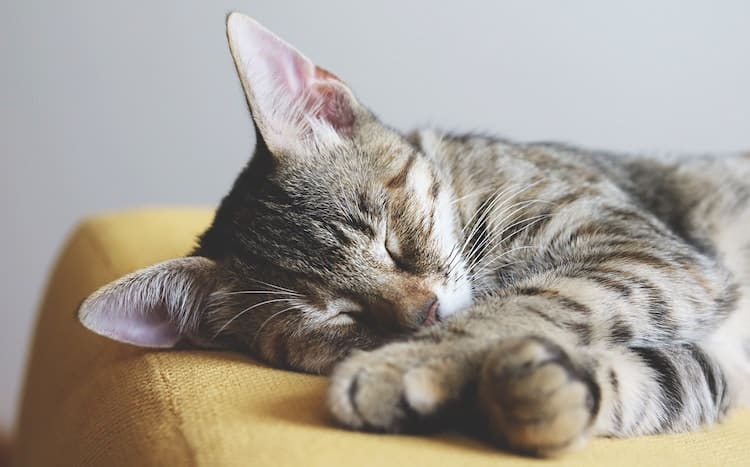American novelist Scott F. Fitzgerald once wrote: “The worst thing in the world is to try to sleep and not to.” Many who struggle to sleep well at night might agree with this. Poor sleep quality or quantity negatively impacts our mind, our body, and our spirit. Therefore, doing what we can to improve our hours spent in slumber is crucial for our wellbeing.
Guided sleep meditations are one free and accessible way to enhance deep rest. Many people around the world turn to meditation to sleep better – and for good reasons. We will explore those reasons and more in this comprehensive guide on using meditation for sleep.

How Meditation Helps Us Sleep Better
Why is it that so many people turn to meditation to sleep better? Is this simply a new hype or is there science behind this trend? Over the past decades, much research has been done to look at the connection between meditation and sleep. Science has revealed a variety of potential explanations for why this sleep technique is indeed helpful for so many – and which type of meditations might be supportive in this way. Some of those findings include:
Mindfulness meditation can reduce stress and anxiety.
One of the reasons that many people experience difficulties with sleep is due to stress and anxiety. When we are stressed, our physiology is on high alert. Cortisol levels are heightened, and when this becomes chronic, it can interfere with sleep. Since mindfulness meditation can induce the relaxation response, this may be one of the reasons people find this technique supportive of sleep.
Research suggests that visualization can also induce relaxation and support sleep.
Another common meditation for sleep technique is visualization. Visualization involves the creation of mental images – and in sleep meditations, the focus is on cultivating mental imagery that evokes peace, ease, and relaxation. Where stress and anxiety are contributing to sleep issues, visualization may be supportive.
Mindfulness meditation may be effective in reducing chronic pain, which is a root cause of sleep issues for many.
One study looked at the impact of mindfulness meditation on sleep-related outcomes in individuals with fibromyalgia syndrome. The results found that the intervention led to significant improvements across all measures as compared to a control group. For those struggling with fibromyalgia, mindfulness meditation may therefore be supportive.
Mindfulness techniques can improve sleep quality by enhancing emotion regulation.
Furthermore, another study that found that between intrusive thoughts, avoidance, and hyperarousal and lower overall sleep quality there existed a correlation. This study found that mindfulness can be of support in sleep issues where these factors are present as the technique of mindfulness can increase self-awareness and support non-reactivity to negative thoughts. This supports emotion regulation.
These are just a selection of some of the potential explanations for why certain types of meditation can support us in falling asleep. Since there are many different types of meditation (i.e. body scans, mindfulness of breathing, TCM), there is no single mechanism to explain why the practice is generally helpful. Bear in mind that some meditation styles are more activating than others and that the ones used for sleep are more mindful, nurturing, or calming in nature. Seek out meditations that are explicitly designed for sleep or that use techniques that help to calm and relax mind and body.
A ruffled mind makes a restless pillow.
- Charlotte Brontë -
4 Meditation for Sleep Techniques
As noted, there are a variety of different meditation techniques we can explore to enhance sleep quality. If you are looking to use meditation to sleep better, consider the following primary techniques:
Mindful Breathing or Deep Breathing
First and foremost, breath awareness is a common technique used in many different meditation practices. When it comes to sleep, mindful breathing can act as an anchor for our attention and deep breathing can be used to enhance the body’s relaxation response. Many guided sleep meditations begin with awareness of the breath.
Body Scan Technique
Another popular meditation for sleep technique is the basic body scan. Body scans invite us to draw our attention through the physical body, which can help to quiet a racing mind. Some body-based meditation practices also include active relaxation, such as the technique known as Progressive Muscle Relaxation.
Visualization
As mentioned, visualization is another common practice in sleep meditations as it helps to induce the relaxation response. You can listen to a guided visualization practice to explore this technique or you can take your own inner journey to a place of peace. If opting for the latter, call to mind a place in the world (such as a beach or a forest) where you feel calm, at ease, and supported. Notice how visualizing this place impacts the state of your body and mind.
Calming Music
Furthermore, many sleep meditations include a backdrop of peaceful music to help us sink off into slumber. As we listen to music, our body responds – and research has shown that music can have a soothing effect on the body (such as by lowering cortisol). Meditations for sleep might incorporate piano music, nature sounds, or other calming vibrations.
In addition, guided meditations can include other techniques, such as counting, positive affirmation repetition, or intention setting. Sleep meditations are therefore wide and varied. Take your time to discover which techniques are most beneficial for you.

A Self-Guided Meditation for Sleep
Below we offer ten different guided sleep meditations to help you sleep better. However, it is also helpful to know how you can practice on your own. If you wake in the middle of the night, for instance, you might find it too distracting to reach for your phone to play a guided meditation. Read through the following instructions and keep these notions tucked away for later use.
Begin by recognizing what is happening – with compassion and curiosity.
Often, when we realize we are struggling to fall asleep (or to stay asleep), we begin to panic. This is natural, but panic will only increase stress within the body and mind. Instead, see if you can just become aware of this moment without judgment, fear, or worry. Take a few cleansing breaths if this feels helpful.
Cultivate self-compassion for this experience.
Speak to yourself the way you would speak to a loved one if they were struggling to fall or stay asleep. What words would you use? What would your energy be like towards them? Offer to yourself the same level of reassurance and care that you would offer someone you love.
Tune into your body.
Draw your attention towards the crown of your head and slowly scan your awareness towards your toes. If you come across any areas of tension that can be safely and comfortably released, let go of that tension. Breathe love into any areas of your body that are tense or uncomfortable.
Once you finish the body scan, shift your attention towards your breath.
Notice if you can hear your breath. Liken your breath to soft waves (if that is a comforting visualization for you) and if your mind wanders, remember that your breath is an anchor. Stay present with that steady ebb and flow, knowing you do not have to change your breath in any way. Allow it to deepen or slow down on its own, but do not force anything.
Stay with your breath until you drift off to sleep.
If your mind has trouble staying present with the breath, practice another body scan. And remember to stay curious, compassionate, and non-judging towards your experience. Take care of yourself – mind and body – trusting that sleep will indeed come to nourish you.
10 Guided Sleep Meditations to Sleep Better
It is helpful to know how we can meditate into sleep on our own. However, guided sleep meditations can be helpful, especially in the beginning as we become more familiar with these techniques. Consider the following practices, bookmarking your favorites to return to when needed.

If the thought of the ocean brings you a sense of peace and ease, consider this guided ocean visualization to sink into slumber. This practice includes a guided meditation script that may be helpful if you are a mindfulness teacher and wish to support others with sleep challenges as well.
For those that feel drawn to the sound of a crackling log fire, consider this sleep meditation by Jason Stephenson. It includes calming sounds and visualizations to support listeners in relaxing and drifting into sleep.
This four-minute practice is a wonderful way to get ready for sleep. Deepak Chopra invites us to cultivate an attitude of relaxation before offering guidance for breath awareness and mantra repetition. It is a great way to transition between wakefulness and sleep.
One of many guided meditations in the Sleep Meditations course, the gratitude body scan practice offers a twist on the classic body scan. As it guides us to notice different parts of the physical body, it also calls us to cultivate appreciation for these parts.
In this guided meditation, Jeremy Lipkowitz uses the technique of counting out the breath. This method of focusing our attention can help to cultivate a quiet mind, which supports us in drifting off to sleep.
For those that feel drawn to using music as a tool for sleep, this deep sleep meditation track is composed with seven solfeggio frequencies to help bring balance to the seven chakras. There are no words spoken in this track; it is the music that guides you into relaxation.
Another sleep meditation by Jason Stephenson, this is a practice that invites us to let go and to trust the universe. This meditation includes a variety of meditation for sleep techniques, such as breath awareness, body scanning, and relaxing music.
With a soft backdrop of gently flowing water, this guided meditation led by Sean Fargo is an invitation to tune into the physical body and to relax. It is a ten-minute practice that can help us transition from the activity of the day into the restfulness of sleep.
Another music track to fall asleep with is this recording of rain sounds. The ten-hour track serves as a gentle backdrop to calm the mind and guide us deeper into relaxation. You can listen to this track and focus strictly on the sounds or you can practice other meditation techniques alongside it (i.e. breath awareness).
Lastly, this guided meditation led by Jeremy Lipkowitz helps us to cultivate the quality of equanimity – a state of inner peace and balance. As your inner world comes into peace, the physical body will more effortlessly drift off to sleep.
REFERENCES
- 1https://www.sleepfoundation.org/insomnia/treatment/meditation
- 2https://www.psychologytoday.com/us/blog/sleep-newzzz/202004/the-effects-cortisol-your-sleep
- 3https://www.frontiersin.org/articles/10.3389/fpsyg.2018.01365/full
- 4https://www.researchgate.net/publication/346367535_The_Relationship_between_Mindfulness_and_Sleep_Quality_is_Mediated_by_Emotion_Regulation
- 5https://www.stress.org/take-a-deep-breath
- 6https://www.verywellmind.com/visualization-for-relaxation-2584112
- 7https://www.ncbi.nlm.nih.gov/pmc/articles/PMC3734071/







